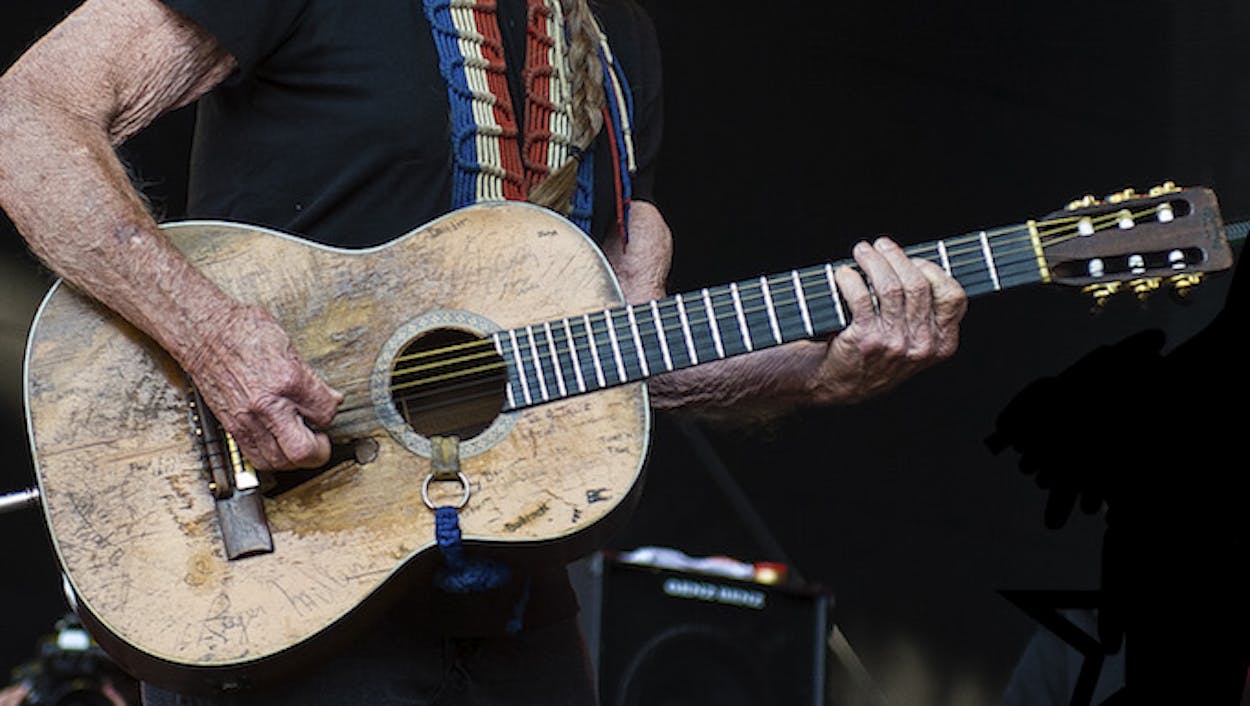Is there an instrument as iconic as Trigger? Willie Nelson’s beat-to-hell Martin classical acoustic guitar is known around the world by name, and its acoustic resonance is as familiar, in its way, as Nelson’s thin, reedy voice.
As Michael Hall wrote in his fairly definitive biography of Trigger for Texas Monthly back in 2012, Nelson first acquired the guitar in 1969, after a drunk patron at a venue in Nashville broke his old guitar. It didn’t come cheap—Trigger cost $750 (close to $5,000 in 2015 dollars), but Nelson’s ascendance coincided with his acquisition of the instrument. Now Rolling Stone has put together the above twelve-minute documentary, narrated by Woody Harrelson, recounting some of the highlights.
Former Texas Monthly senior editor and Nelson biographer Joe Nick Patoski helps tell the story, as does Jerry Jeff Walker and a number of other musicians who’ve spent time on stage and in the studio with Willie and his guitar.
Willie Nelson’s journey from square Nashville songwriter to Texas outlaw legend is built around Trigger in ways that aren’t just symbolic—it was one of the first acoustic guitars to be properly amplified with a pickup, which very much defined Nelson’s sound in the seventies and beyond.
The Rolling Stone documentary spends a lot of time affirming the musical significance of Trigger, and the cultural significance of it can’t be underestimated either—the list of musicians who’ve autographed the guitar’s body comprise a who’s who of country music, and the beat-up body of the guitar is cast in bronze outside of the ACL Live theater in Austin. Abraham Lincoln had a top hat; Alfred Hitchock had a shadow; Captain America has a shield; Willie Nelson has Trigger.

Of course, one thing that the film doesn’t get to is that there was a time when Willie almost didn’t have Trigger. As Robert Draper detailed in Texas Monthly back in 1991, when Nelson’s IRS troubles threatened to catch up to him, they nearly claimed Trigger too:
As long as I got my guitar, I’ll be fine,” Willie has often said, referring to Trigger, the legendary retooled Martin six-string he rescued from his burning Tennessee ranch house in the late sixties. Willie’s attachment to his old guitar was a bond that bordered on spiritual. “When Trigger goes, I’ll quit,” he has been heard to say. But what if the feds came after Trigger? They had done it before, he’d read somewhere—taken an entertainer’s guitar and auctioned it off for $45,000. It was one possibility that truly worried him. Two weeks before the IRS raid, Willie began to sense that negotiations with the agency were faltering. He asked the person he trusted most—his eldest daughter, Lana—to remove Trigger from the studio and personally deliver it to him in Hawaii. Lana did so, and Trigger was now in Willie’s hands—but for how long? Willie could manage without his recording studio, his golf course, and his Hill Country acreage. Without Trigger, though, all bets would be off.
Willie got to keep Trigger, of course, and as Rolling Stone’s documentary affirms, the fact that he did is part of the reason we’ve had so many decades worth of Willie to celebrate. Red Headed Stranger might be the album that the documentary cites as the perfect example of Willie and Trigger working in tandem, but it’s a relationship that’s blossomed in the decades since: albums like Spirit and Teatro are showcases for the guitar, and to this day, it’s still the centerpiece of Willie Nelson’s performances. We’re lucky he landed in that guitar shop in 1969 to find it. In honor of that fact, press play above and revisit Michael Hall’s exquisite piece.








